Living in compact spaces doesn’t mean sacrificing style or comfort. With smart design strategies, even the coziest areas can become functional and inviting. This guide reveals creative ways to reimagine your environment, blending practicality with personal flair.
Discover how simple modifications can dramatically improve daily life. From clever storage hacks to convertible furniture, these ideas help maximize every inch. Projects range from weekend-friendly upgrades to full-scale renovations, offering versatile solutions for renters and homeowners alike.
Each concept prioritizes affordability and sustainability. Learn to repurpose materials, integrate vertical gardens, or install space-saving shelving systems. These approaches not only enhance usability but also reflect your unique personality.
Table of Contents
Key Takeaways
- Transform limited square footage with adaptable layouts
- Combine style and utility through multi-purpose installations
- Choose upgrades matching your skill level and budget
- Address common challenges like storage and lighting
- Create a personalized retreat without major construction
- Use eco-friendly materials for long-term savings
Whether you’re refreshing a studio apartment or optimizing a mobile dwelling, these projects empower you to craft a home that truly fits your lifestyle. Start with high-impact changes that deliver immediate results, then build toward more complex improvements.
Introduction to DIY Tiny House Projects
More individuals are reshaping their compact environments through hands-on innovation. This movement combines practical design with self-expression, letting people craft spaces that mirror their values. Personalized layouts and clever storage systems prove that limited square footage can feel both spacious and intentional.
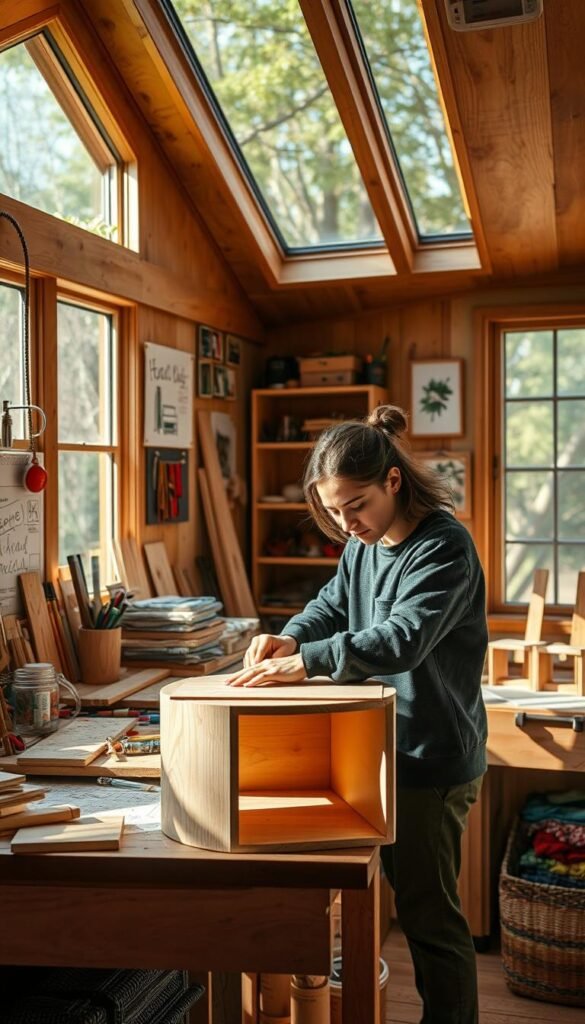
Building your own solutions offers unmatched flexibility compared to store-bought alternatives. Many discover that creating foldable furniture or modular shelving becomes a gateway to financial independence. Every custom detail reduces reliance on mass-produced goods while lowering environmental footprints.
These hands-on upgrades range from beginner-friendly adjustments to advanced renovations. Start with under-bed organizers or magnetic wall panels before tackling loft expansions. Each modification teaches valuable skills, from measuring accuracy to material selection.
Owners often find commercial products don’t address their specific spatial challenges. Designing your own fold-down desk or staircase drawers ensures every corner serves multiple purposes. This approach turns constraints into creative opportunities, resulting in homes that truly fit daily rhythms.
Understanding core principles helps prioritize changes with the biggest lifestyle impact. Focus first on zones where improved functionality reduces stress, then layer in aesthetic touches. This strategic method builds confidence while transforming how you experience compact living.
Planning Your Tiny Home: Design & Floor Plans
Smart spatial organization transforms limitations into opportunities. Professional builders rely on detailed plans to ensure structural integrity and code compliance. Companies like Tumbleweed offer free 90-page guides with step-by-step instructions, while premium options ($129-$490) provide specialized designs for unique needs.
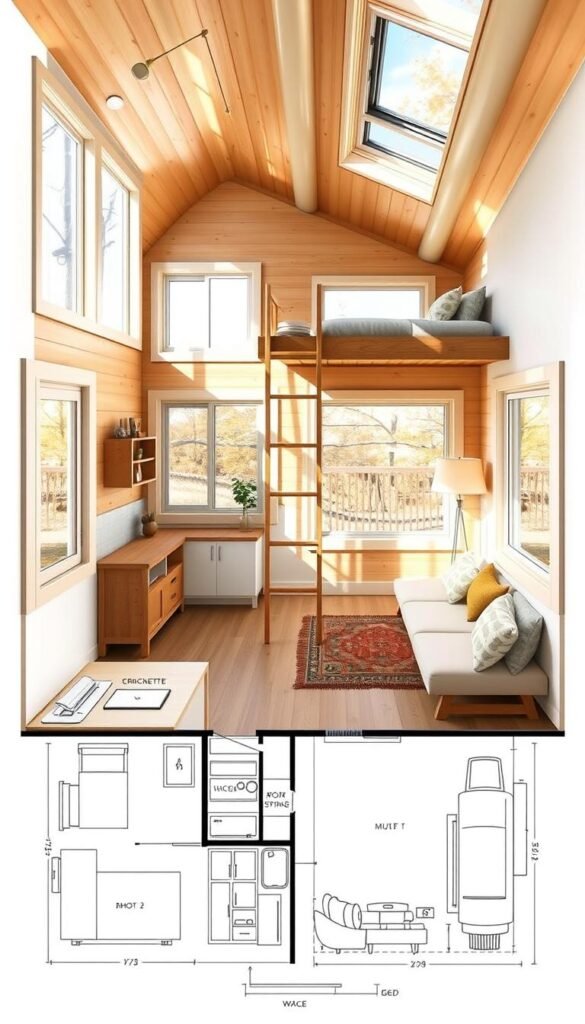
Choosing the Right Layout
Evaluate daily routines to identify essential zones. Do you cook elaborate meals or work remotely? Coastal retreats might prioritize outdoor access, while urban dwellings need vertical storage. Study existing floor plans to learn load-bearing wall placement and ventilation requirements.
Personalizing Your Floor Plan
Transform generic templates into tailored solutions. A farmhouse-style kitchen island could double as a breakfast bar and laptop station. Use sliding panels to merge sleeping and living areas during daylight hours. Always consult engineering specs before altering support beams or window placements.
| Plan Type | Price Range | Square Footage | Best For |
|---|---|---|---|
| A-Frame Weekender | $199 | 180-240 | Seasonal use |
| Off-Grid Cabin | $349 | 300-400 | Remote locations |
| Elevated Cottage | $449 | 260-320 | Flood-prone areas |
| Modern Farmhouse | $490 | 350-420 | Family living |
Create measurement checklists and timeline charts before purchasing materials. This prevents costly errors like ordering oversized appliances or mismatched lumber. Balance creativity with practicality – a loft bed saves space but requires secure railings.
Benefits of Embracing a Tiny House Lifestyle
Opting for a minimalist footprint unlocks unexpected advantages beyond square footage. Compact dwellings slash housing expenses while offering financial flexibility in today’s competitive real estate market. Many owners eliminate mortgage debt entirely, redirecting funds toward travel or personal goals.
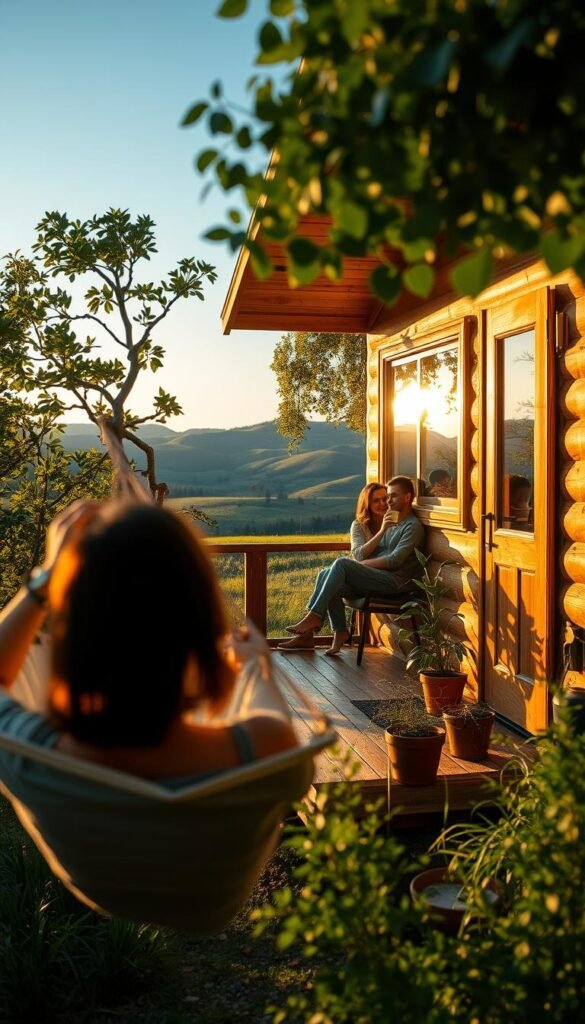
Smaller spaces demand fewer resources for heating, cooling, and repairs. Utility bills often drop by 60-80% compared to traditional homes. Eco-conscious builders frequently integrate solar panels or rainwater systems, further reducing environmental impact.
The simplified approach naturally discourages clutter accumulation. Residents prioritize quality over quantity, focusing on experiences rather than possessions. This mindset shift decreases stress while creating room for meaningful connections.
Construction timelines typically span weeks instead of months, especially when using prefabricated components. Many jurisdictions classify these structures as temporary, bypassing complex permit processes. This accessibility makes homeownership achievable for those priced out of conventional markets.
Communities thrive through shared knowledge and resource exchanges. Meetups and online forums help enthusiasts troubleshoot challenges while celebrating creative solutions. This collaborative spirit transforms housing from a financial burden into a springboard for life-enriching choices.
Building a Tiny House: A Step-by-Step Construction Process
Constructing a compact dwelling requires careful planning and methodical execution. The 10-phase system begins with trailer preparation and progresses through critical stages like framing, utility installation, and exterior finishing. Each action builds on the last, making proper sequencing vital for structural integrity.
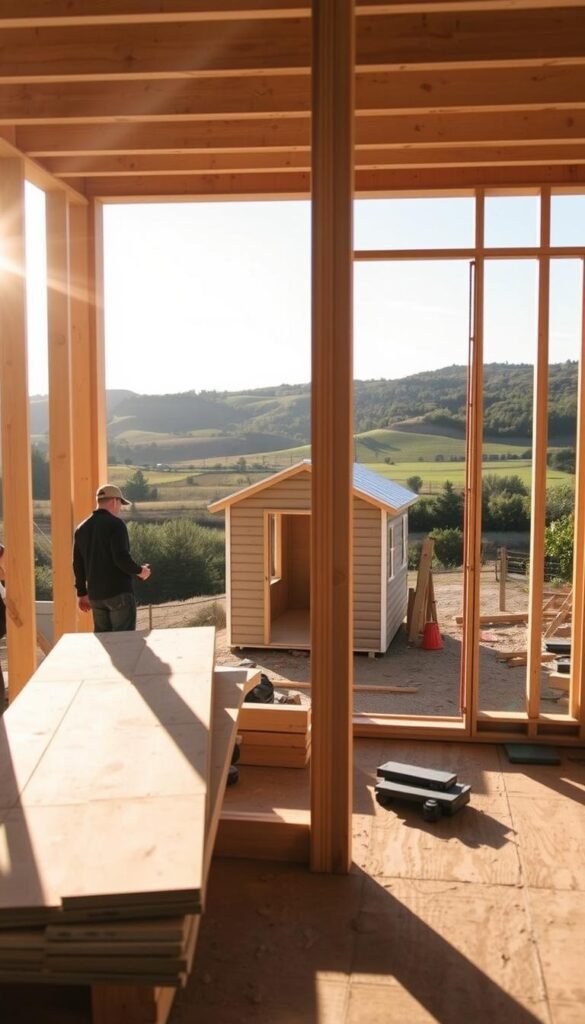
Establishing Your Foundation and Framing Structure
Start by securing a stable base. Mobile units typically use reinforced trailers, while permanent setups require concrete slabs or cement blocks. Soil tests and local zoning laws determine the best approach. Builders then map their floor plan with precision-cut lumber, creating horizontal frameworks before raising walls.
Roofing and Exterior Assembly
Weatherproofing becomes crucial during this phase. Metal roofing panels or asphalt shingles provide durable protection against elements. Install windows and doors using flashing tape to prevent leaks. Many opt for lightweight siding materials like vinyl or reclaimed wood to balance aesthetics and mobility needs.
Professional estimates suggest 830-1,300 total hours for completion. First-timers should allocate extra time for complex steps like electrical work. Break tasks into manageable chunks – complete framing before tackling plumbing, and finish exterior surfaces before interior details. This systematic method reduces overwhelm while ensuring quality results.
Setting a Budget and Managing Costs
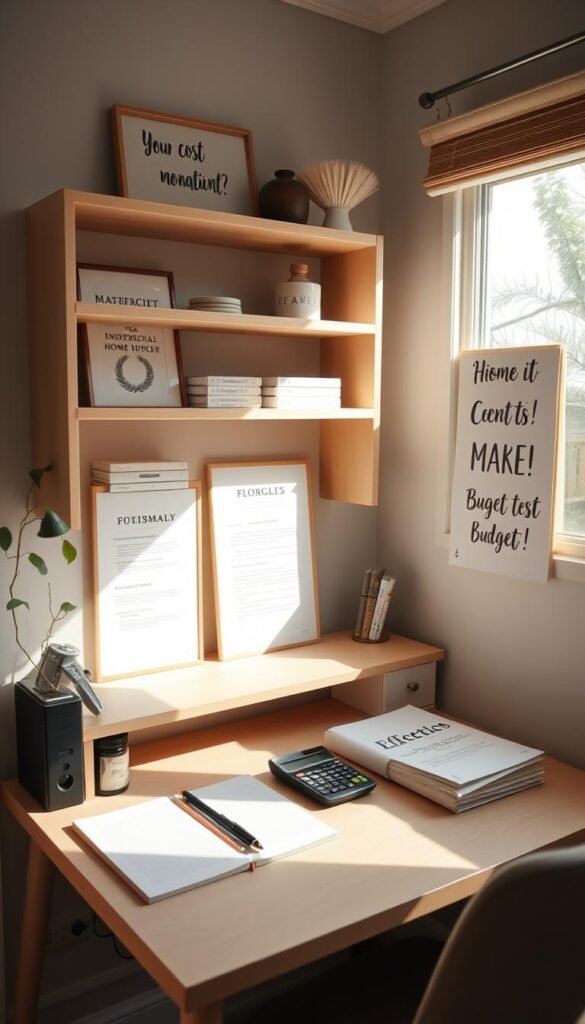
Financial planning forms the backbone of successful compact living projects. Current estimates show a $50,000 budget covers materials and tools for a 120-square-foot build in 2024. This reflects a 150% increase from outdated $20,000 projections due to rising supply expenses.
Smart approaches spread investments over time. Many begin with $15,000 upfront, then allocate $1,000 monthly. This phased method reaches completion in three years while balancing cash flow.
Hidden expenses often surprise first-time builders. Monthly rent payments during construction add $36,000 over 36 months, pushing real costs to $87,000. Track every dollar spent on storage units or temporary housing.
Effective strategies include buying materials during holiday sales and repurposing quality reclaimed items. Reselling specialized tools post-construction recoups 30-40% of initial purchases. Always reserve 20% of your budget for unexpected issues like weather delays or code updates.
Comparing self-built versus pre-made options reveals significant savings. Labor fees account for 45-50% of professional builds, but your time investment matters. Dedicate weekends and evenings strategically to avoid burnout while maintaining progress.
Sourcing Quality Materials for Your Build
Smart material choices form the backbone of any successful compact dwelling. Builders face unique challenges due to constant weather exposure and space constraints. Selecting components that serve multiple purposes ensures structural stability while maximizing every square inch.
Selecting Sustainable and Durable Options
Spray foam insulation stands out for its dual benefits. It creates airtight seals while reinforcing walls, allowing slimmer profiles that preserve interior space. This solution cuts energy costs by up to 40% compared to traditional alternatives.
Exterior surfaces demand extra protection. Metal roofing and fiber-cement siding withstand harsh conditions better than standard wood. These options require less maintenance despite higher upfront costs.
Framing decisions impact both durability and construction complexity. Steel offers superior strength but needs specialized tools. Wood remains popular for its affordability and ease of modification during the building process.
Eco-conscious builders prioritize reclaimed lumber and recycled steel. Local salvage yards often stock unique pieces at 30-50% below retail prices. Always verify material certifications to ensure safety standards.
Allocate significant time for research and price comparisons. Create a checklist comparing weight limits, thermal ratings, and supplier warranties. This prevents costly mistakes and ensures components work together seamlessly.
DIY tiny house projects: Creative Ideas for Personalization
Tailoring compact living areas to individual needs sparks creativity while maximizing functionality. Clever modifications turn generic layouts into reflections of personal style, blending practical solutions with aesthetic touches. These upgrades address unique spatial challenges without requiring major renovations.
Wall-mounted workspaces offer flexibility for remote professionals. Fold-down desks with integrated lighting create office-ready zones that vanish when unused. Pair these with built-in seating featuring hidden compartments to store documents or tech accessories discreetly.
Multipurpose furniture transforms daily routines. Convertible tables expand for meals then collapse against walls. Storage-integrated staircases and ceiling-mounted nets keep seasonal items accessible yet out of sight. These solutions maintain clean sightlines while accommodating diverse activities.
Kitchen enhancements prioritize efficiency through vertical organization. Magnetic spice racks and fold-out cutting boards optimize limited counter space. Hanging pot holders and rotating shelves ensure every utensil remains within reach during meal preparation.
Bathrooms benefit from space-conscious fixtures like corner sinks and sliding shower doors. Recessed shelving in shower walls stores toiletries without protruding into walkways. Mirrored cabinets amplify natural light while hiding grooming essentials.
Lighting customization elevates both mood and utility. Dimmer switches adjust ambiance for different occasions, while LED strips under cabinets illuminate task areas without glare. Strategic mirror placement doubles sunlight exposure in window-limited spaces.
Every modification should balance personal preferences with practical needs. Start with high-impact changes like modular shelving systems before tackling complex installations. This approach creates homes that truly adapt to evolving lifestyles.
Essential Tools and Techniques for Building Tiny Homes
Building compact dwellings demands strategic tool selection and proven methods. Professionals invest over 1,000 hours completing these structures, with 830+ hours dedicated solely to construction phases. Proper preparation prevents costly errors and ensures structural reliability.
Must-Have Tools and Equipment
Start with core carpentry gear: circular saws, drills, and laser levels ensure precise cuts and installations. Add specialized tools like wire strippers and pipe cutters for electrical and plumbing work. Pneumatic nail guns speed up framing tasks while maintaining joint integrity.
Tumbleweed’s data shows material sourcing consumes 80-200 hours. Create checklists for fasteners, insulation, and weatherproofing supplies. Rent heavy-duty equipment like jack stands for trailer preparation – this step alone takes 10-60 hours.
Best Practices and Safety Tips
Secure walls with temporary braces during assembly to prevent collapses. Always test electrical circuits before enclosing them in walls. Use fiberglass ladders with stabilizer bars when working on elevated areas.
Protective gear proves non-negotiable. Safety glasses shield eyes from flying debris during cutting tasks. Thick work gloves improve grip while handling rough lumber. Schedule regular tool maintenance checks to avoid mid-project breakdowns.
Advanced techniques help build efficiency without sacrificing quality. Pre-drill pilot holes to prevent wood splitting. Stagger wall studs to create deeper cavities for insulation. These methods optimize both time and material usage during the construction process.
For more DIY projects, please check out DIY New Deck for a Tiny House: Simple Guide.



